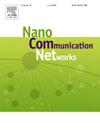Gold-based nanoantenna design using golden ratio optimization for in-vivo communication at terahertz frequency
IF 4.7
4区 计算机科学
Q2 ENGINEERING, ELECTRICAL & ELECTRONIC
引用次数: 0
Abstract
In this article, a novel microstrip patch antenna of size 210 × 205 × 22 operating in the terahertz band is proposed. We then perform optimization of the proposed antenna using the Golden Ratio technique to realize an antenna with reduced dimensions and better performance. The optimized nanoantenna has reduced dimensions of 120 × 160 × 14 ( 71.61 % reduction in volume); improved return loss S11 ( -45.43 dB); gain ( 5.29 dBi), and bandwidth (156.9 GHz i.e., 45% more). The results are validated through an equivalent circuit model (ECM) in Advanced Design System (ADS), demonstrating good agreement with the CST Studio results. Next, a human heart-phantom model has been created and tested for each designed scenario. It examines the interactions between the heart tissues and the proposed antenna, and it identifies the substrate material that performs the best. The results show that polytetrafluoroethylene (PTFE) material performs better than other substrates. Additionally, the research includes an analysis of the link budget of terahertz channels in the intrabody nanocommunication networks—a bio-medical application. The findings indicate the feasibility of using nanoantennas for practical in-vivo nanocommunications.

基于黄金比例优化的太赫兹体内通信金基纳米天线设计
本文提出了一种在太赫兹波段工作的210 × 205 × 22 μm3微带贴片天线。然后,我们使用黄金比例技术对所提出的天线进行优化,以实现缩小尺寸和提高性能的天线。优化后的纳米天线尺寸减小为120 × 160 × 14 μm3(体积减小约71.61%);改进收益损失S11 (<;-45.43 dB);获得(比;5.29 dBi)和带宽(156.9 GHz,即增加45%)。通过先进设计系统(ADS)中的等效电路模型(ECM)验证了结果,证明与CST Studio的结果吻合良好。接下来,我们创建了一个人体心脏模型,并对每个设计的场景进行了测试。它检查了心脏组织和拟议天线之间的相互作用,并确定了性能最好的衬底材料。结果表明,聚四氟乙烯(PTFE)材料的性能优于其他基材。此外,该研究还分析了太赫兹通道在体内纳米通信网络中的链路预算,这是一种生物医学应用。研究结果表明,纳米天线在实际的体内纳米通信中是可行的。
本文章由计算机程序翻译,如有差异,请以英文原文为准。
求助全文
约1分钟内获得全文
求助全文
来源期刊

Nano Communication Networks
Mathematics-Applied Mathematics
CiteScore
6.00
自引率
6.90%
发文量
14
期刊介绍:
The Nano Communication Networks Journal is an international, archival and multi-disciplinary journal providing a publication vehicle for complete coverage of all topics of interest to those involved in all aspects of nanoscale communication and networking. Theoretical research contributions presenting new techniques, concepts or analyses; applied contributions reporting on experiences and experiments; and tutorial and survey manuscripts are published.
Nano Communication Networks is a part of the COMNET (Computer Networks) family of journals within Elsevier. The family of journals covers all aspects of networking except nanonetworking, which is the scope of this journal.
 求助内容:
求助内容: 应助结果提醒方式:
应助结果提醒方式:


